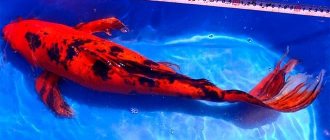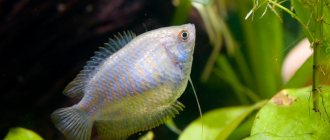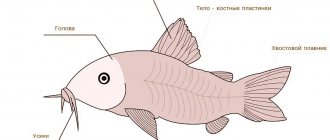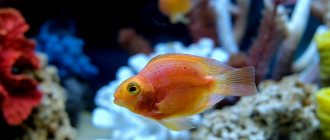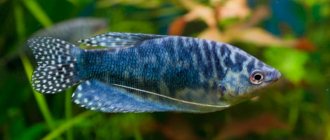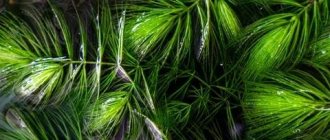Motherland
More than 1000 years ago, in the homeland of goldfish, China and Korea began to engage in fishing. The founders of goldfish - crucian carp - were found in the catches. People started keeping them as pets in glass tanks of water.
The silver carp, paradoxically, is the ancestor of the golden carp.
Later, Chinese breeders began breeding and preserving the best genetic traits in goldfish. As a result of the work, it was possible to obtain many varieties of breeds with different tail sizes, body shapes, colors and life expectancy. They became the founders of truly popular fish breeds.
The first mention of fish with red scales was recorded in 265 AD during the Jin Dynasty.
In the 16th century, red crucian carp came to Japan, where new varieties were developed. Breeders tried to develop harmonious and colorful forms, after which the Japanese were recognized as the founders of the distribution of goldfish.
In the 17th century, trade actively developed. Therefore, pets quickly spread throughout Europe, and later throughout the world.
Disease Prevention
Goldfish are very delicate creatures that can die if the proper conditions are not met. The presence of a disease in a fish can be determined by the degree of its mobility, appetite, shine and brightness of scales.
You should also pay attention to the dorsal fin. If it does not stay upright, then the fish’s health is not all right.
Also, the disease may be indicated by a plaque that suddenly appears on the body.
Sick fish should be immediately isolated from healthy fish. It is best to place it in a large aquarium with slightly salted water.
It is recommended to maintain a concentration of 20 g of salt per 1 liter of clean water. The water temperature in the aquarium for a sick goldfish should not exceed 18°C.
Also learn about the intricacies of raising parrotfish in your aquarium.
In such conditions, you need to keep it for three days, while replacing the water solution daily.
The most common diseases in goldfish are:
- Cloudiness of scales and scabies. With such symptoms, it is necessary to immediately replace all the water in the aquarium.
- Individuals develop white threads in a perpendicular direction to the body - hyphae . These are signs of dermatomycosis or a common fungus.
- White, gray or pink tumors on the body and fins . This is how fishpox manifests itself. Such neoplasms do not pose a threat to life, but they spoil the beauty of the fish. Unfortunately, fishpox cannot be cured.
- A terrible threat for goldfish is dropsy followed by sepsis. You can save the fish only at the very first stage of the disease. The sick individual must be moved to running clean water and bathed in a solution of potassium permanganate every other day for 15 minutes.
- Inflammation of the stomach . It can be caused by poor food or prolonged feeding of dried daphnia, gammarus and bloodworms.
Did you know? Goldfish are extraordinary gluttons. They will eat as long as food is given to them. Overeating is the most common cause of death. Therefore, you should not give in to the energetic behavior of fish, which may lead you to believe that they are still hungry.
Setting up and launching an aquarium
An aquarium is the basis for keeping red crucian carp at home. Several rules must be followed to make pets feel comfortable:
- The individuals are large; one requires at least 7 liters of water.
- The volume of the aquarium directly depends on the number of individuals in it.
- Golden fish are a schooling breed; in the wild they prefer to stay in small groups, but they also feel good alone.
- It is preferable to choose horizontally elongated aquariums so that the individuals have enough space to swim. This is especially true for large aquarium inhabitants so that they can swim up and down. In a narrow space, fish will be uncomfortable.
- Crucian carp are voracious fish, so they excrete a large amount of waste. The tank is equipped with a powerful water filter. In addition, they are constantly hoping to find some food and do not feel full. Goldfish in captivity often die from overeating.
- Coarse soil is laid at the bottom. The fish will constantly sort through the rocks at the bottom in search of food. Fine sand will get into their stomach - this is harmful.
- The design of the bottom can be anything, the main thing is that the corners of the decorations are not sharp, as this can injure the pet’s body.
- Be sure to install a compressor, it will saturate the water with oxygen.
- The water temperature should be no higher than 23 degrees Celsius.
Purchase and test all equipment before purchasing fish.
Before buying fish, prepare the aquarium. All of the above parameters are observed. The first start of all mechanisms is carried out. The fish are released into the “new home” after at least 3 hours, so that the water has time to be sufficiently saturated with oxygen and the chlorine has completely evaporated.
Care and maintenance
It is not difficult to care for fish at home. The main thing is to monitor your diet and clean water. Aquarists comply with all parameters; they help preserve the lifespan of the fish.
| Volume of water (liters per 1 individual) | Temperature (°C) | Acidity (pH) | Hardness (dGH) |
| 50 | 18-23 | 6-8 | 8-25 |
The water must be changed as it becomes dirty, but at least once a week. It is harmful to change the water in full; we recommend updating 20 - 30% of the total volume.
Red crucian carp prefer cool water. In summer, most species can be released into decorative ponds. For them, this will serve as variety and health.
It is important to constantly maintain the water temperature in the desired range; overheating can lead to death.
Be prepared for the fact that after such a vacation your fish will gain a lot in height and weight!
The fish are more tolerant of other parameters. The main thing is that there are no sudden changes. The pets' bodies will not be able to undergo dramatic restructuring, which will result in death.
When using tap water for an aquarium, use a special conditioner to bind toxic substances. It is used according to the instructions. It binds chlorine and other substances, and also saturates the water with essential microelements.
Aquasafe from Tetra can quickly turn tap water into fish-livable water.
Some aquarists simply settle the water, believing that all the toxins for the fish settle at the bottom. In fact, only chlorine compounds break down, and heavy metals remain. Using such water is unsafe.
Tank selection
Before buying a pet for an artificial pond at a pet store, you should figure out what kind of aquarium is needed for a goldfish and how to properly equip it. To do this, you need to accurately calculate what size it will reach. Also, when choosing an aquarium, you need to consider the following nuances:
- The volume of water must be at least 50 liters per individual.
- The tank has a traditional shape - a parallelepiped. The length is twice the height, and the height is equal to the width.
- When keeping and caring for aquarium goldfish, it is necessary to take into account that they cannot be placed in containers with curved glass. Because of this, the world for aquatic inhabitants is distorted, and they feel uncomfortable.
- The soil at the bottom should not be shallow, as fish like to dig in it and can swallow pebbles and die. Sand can be used as soil.
You can use sand or small pebbles as soil. - It is necessary to maintain the water temperature within 18-30 degrees Celsius: for long fish it should be 18-25 Celsius, for short ones - 21-29 Celsius. Salinity should be maintained at 12-15%. The hardness must be at least 8.
- The aquarium should be equipped with round-the-clock aeration.
- Constant water filtration should be ensured. Since fish like to dig through the soil, turbidity rises to the top. The filter capacity should be 3-4 aquarium volumes per hour. Both external and internal filters are suitable and should be washed at every water change.
- The water is changed every week, and a quarter to a third of the volume of the container is changed.
The water in the aquarium should be changed every week - To regularly clean the soil you need a siphon.
- An ultraviolet water sterilizer can also be helpful. By killing parasites and bacteria, it prevents external algae from blooming.
- An artificial pond must contain safe decorative elements: stones and various objects without sharp corners, plants without sharp leaves.
- You need to take care of the availability of plants. They are not only decoration, but also a good way to combat algae. Plants are also capable of absorbing nitrogen and supplying water with oxygen. They serve as a treat for aquarium pets, saturating their bodies with useful microelements. It is better to choose plants with hard leaves (elodea, fern, lemongrass, anubis) and plant them in pots so that the fish do not damage their roots while digging the soil.
- Before placing fish in the aquarium, you need to “start” it. A young or improperly started tank will lead to death or poisoning of its inhabitants.
Compatibility
You can keep several breeds of goldfish in one aquarium. It is advisable not to combine long-bodied and short-bodied pets. Short-bodied ones are much slower. They will not get enough food. Suitable neighbors:
- zebrafish;
- catfish;
- Cardinals.
Since red crucian carp are cold-loving species, they cannot live in the same aquarium with tropical fish.
Goldfish compatibility chart - an assistant when choosing neighbors.
Also, you should not put small breeds into the tank as neighbors; they can become food for goldfish. The same applies to overly large individuals that will devour crucian carp and bite their tails.
Diseases
Anyone who has an aquarium with goldfish at home should know the symptoms of diseases that they should pay attention to and sound the alarm. These include:
- clouding of the eyes, increase in their size;
- unusual movements around the aquarium;
- bloated body of the pet;
- poor appetite or its complete absence;
- spots on the body of any size and color;
- change in gill color;
- plaque or white mucus on the body;
- peeling of scales;
- turn belly up;
- the presence of growths of any nature.
Most of these symptoms are easy to identify visually. The most common diseases that occur in goldfish are:
Ichthyophytiosis
Spots appear on the pet's body in the form of a white coating, they affect the fins. The fish are slowly dying. Treat with salt baths or bicillin.
Branchiomycosis
A fungal infection immediately manifests itself, red stripes appear on the body, and suppuration begins on the gills. Methylene blue helps; the fish is isolated during therapy.
Lepidorthosis
It is characterized by the rise of scales on the body, as a result, in some places it completely falls off and the pet dies.
Fin rot
A dangerous disease that begins with white spots on the head, split fins, and acquire a blue tint. The individual is quarantined and given baths with malachite green, methylene blue or salt.
Argulez
Small parasites attach themselves to the fish’s body and feed on its blood. Growths are noticeable on the fish. This disease is caused by improper care. Special preparations are added to the water.
Rolling over a pet
If a goldfish swims with its belly up, this indicates a swim bladder disease. Most often they occur due to frequent overeating. The sick individual is taken into quarantine and food is limited.
Asphyxia
Fish's gills are always slightly open, which means they don't have enough oxygen. There may be problems with the compressor.
Embolism
Occurs due to oversaturation of oxygen in water. The pet's skin darkens and blisters appear on the body. They regulate the parameters of the habitat and everything is restored.
Rubella
An infectious disease, small red dots appear on the skin of the fish. Treatment is carried out with special drugs and antibiotics.
Even with timely assistance, it is not always possible to save your pets. If any signs are present, it is better to quarantine the sick individual. To do this, it is advisable to have a separate aquarium or glass tank with a compressor.
Content Features
Aquarists have been arguing about how difficult the care and maintenance of goldfish are for many years. Some believe that golden beauties are able to survive in harsh conditions, others shout that to successfully keep pets you need to follow strict rules. Indeed, despite the fame and popularity of goldfish, this phenotype is not suitable for those who are not ready to devote time and effort to their pet.
The main rule for keeping a goldfish comfortable is to buy a spacious aquarium. Contrary to popular belief, these golden underwater inhabitants are not capable of living in cramped containers - by placing the fish in a 15-20 liter tank, the owner dooms it to certain death. To successfully keep two wards you will need an aquarium with a volume of at least 100 liters, equipped with a good aerator and filter. It is better to choose a classic shape - rectangular; fish will be uncomfortable in cylindrical or cubic containers.
Water parameters:
- Temperature – 20-23C, for short-bodied species – 23-25C.
- Acidity – 7 pH.
- Hardness – up to 8 dH.
The soil for the tank is selected without sharp edges and particles so that the fish cannot get injured while digging in the soil. Plants for an aquarium with goldfish must be alive - they will maintain biobalance and also serve as a vitamin supplement. Despite the fact that many types of flora will be mercilessly chewed, living vegetation is a prerequisite for keeping pets.
Plants for goldfish you can choose from:
- Schisandra, duckweed, riccia, wolfia.
- Sagittaria, Java moss, hornwort.
Aeration in the aquarium should be constant if there are a small number of plants in the tank. Coverings for goldfish are almost not required - you can place a couple of small figurines for beauty, but large items with sharp edges can cause wounds and illnesses for goldfish.
Reproduction
To breed goldfish at home, it is better to create a separate aquarium for this - a spawning tank. It will be equipped as follows:
- Vegetation with small leaves is placed on the bottom: riccia, duckweed, periofolia and others.
- The stones and soil are removed; the eggs are better preserved on the empty bottom.
- The water temperature is increased to 24 degrees.
- Provide good lighting throughout the day.
After preparing the conditions for spawning, individuals are selected:
- Males grow to sexually mature individuals by the age of one year, and characteristic white spots appear on the gills.
- Females have a more rounded abdomen for containing eggs.
- For 1 female, 2 males are selected.
- The larger the female, the more eggs she will lay.
- Individuals are added to the spawning tank at the end of March so that the first eggs appear by the beginning of summer.
Goldfish spawn until October, if all conditions are created. Egg laying in females occurs gradually. The males chase the females, they touch the plants and drop 10-15 eggs each time. The grains settle to the bottom or attach to plant leaves. The males immediately water them with seed, and fertilization occurs.
The spawning ground for goldfish can be equipped in different ways, but if the bottom is uncovered, the parents can eat their eggs themselves.
After this, the water level in the aquarium is reduced by 15 cm. After sweeping, the optimal water temperature is maintained. On the 4th-5th day of the incubation period, the juveniles appear. The fry appear weakened and take 2 days to adapt. After which they continue to develop into adult fish.
To remove unfertilized eggs, snails are released to the bottom.
Demanding goldfish
There are many different opinions on this issue. Some argue that these decorative representatives of the carp fish family are not whimsical and can survive in any conditions, without spending a lot of money and time on their maintenance.
Others, exactly the opposite, say that when caring for goldfish you need to fulfill a number of mandatory requirements, and they are one hundred percent right. A colorful individual should not be owned by those who are not ready to make efforts for its comfortable living. And the main condition for keeping goldfish is the presence of a large, voluminous aquarium.
Choosing a habitat
To keep fish, it is worth choosing a spacious large aquarium, at the rate of 50 liters of water per inhabitant. If you immediately place adult fish in it, in the presence of high-quality aeration, the density of pets can be slightly increased. Otherwise, decorative individuals will not fully develop, and the frequency of cleaning the habitat will double.
The shape of an aquarium for fish does not matter, but to make caring for its inhabitants easier, it is better to choose the classic rectangular version. Following these rules will make cleaning easier, and the aquatic fauna and flora will receive the necessary amount of light.
Water quality and temperature
Comfortable temperature is not less than 21 and not more than 29 degrees Celsius. The acidity coefficient does not affect the content of the inhabitants, and the alkalinity should not fall below 8 degrees. Golden specimens can easily withstand salinity of about 12-15%.
Aquarium equipment
To keep fish you need simple equipment:
- lighting with the power necessary for the full growth of plants;
- high-quality filter;
- powerful compressor capable of providing high-quality aeration;
- scraper for removing algae and heavy deposits from glass;
- siphon for complete cleaning (read how best to siphon soil).
Plants and soil
The size of soil particles in an aquarium containing representatives of the carp family should not be less than 5 mm. Pebbles and coarse soil best suit these requirements. Fish will not be able to turn over such soil, lift dirt from the bottom, or dig up plants.
The proximity of the golden inhabitants of the aquarium to the flora is not always successful. Large soil is not suitable for fish; in addition, they are so omnivorous that they can dilute their diet with leaves by eating the plant. Therefore, for a prosperous neighborhood, it is worth choosing flora with a reliable root system and rough leaves. Cryptocorynes, anubias, echinodorus, lemongrass, egg capsules, vallisneria, elodea and sagittaria are suitable for this.
Popular types
There are more than 300 varieties of goldfish. The most popular of them:
fantail
The body shape resembles a crucian carp, the body is rounded downward. The fins are red, the cut tail has a white border. Belongs to the round-bodied species.
Veiltail
The graceful fish has different body colors. A distinctive feature is a double tail with sharp edges.
Oranda
It has an unusual appearance due to specific growths in all areas of the head. There are subspecies with beautiful tails, the color of the fish is varied. One of the most popular types of goldfish.
Pearl
The color of the scales is golden-red. The head is small, the body has a spherical shape. There are minor white spots on the scales. Refers to short-bodied.
Tosakin
The most expensive and rare breed. The body is spherical, the tail is fused and forms a circle when swimming. The scales are golden, the fins and tail are white.
Butterfly
Goldfish with an oblong body, scales of various colors. The eyes are large, bulging, the front fins are short, the tail is divided into 2 halves, reminiscent of a butterfly.
There are many types of goldfish. Each breed has its own characteristics. Also among the popular ones are: Jikin, Wakin, Fish-Egg, Ranchu, Lionhead and others.
Kinds
Goldfish are divided into two broad categories:
- Long-bodied individuals - prominent representatives are the comet or wakin. The long-bodied individuals resemble crucian carp in shape and are long-lived.
- Short-bodied - this group is characterized by a body compressed from head to tail. Representatives are the fruit of selection work; a prime example is a telescope or a pearl. These goldfish require more effort and time to care for and maintain than longer-bodied ones.
Despite the fact that there are many varieties of goldfish, not all are extremely popular. Each species differs from each other in the type of scales, shape of fins and eyes, so before purchasing you should carefully study the descriptions of common varieties.
Regular fish
The common aquarium goldfish is the most common inhabitant of artificial reservoirs. The phenotype color is golden-red, but can be yellow, white or black. Representatives of this species are descendants of wild crucian carp, so similar features are clearly visible in the appearance of both fish.
Wakin
The Wakin breed was bred by Japanese breeders and is distinguished by its large dimensions: the size of the fish reaches 30 cm. The body is painted scarlet or milky, but there are specimens that combine both shades.
Riukin
Riukin are unusual fish with a curved body, which is why individuals have a small hump. Among the different color options, the most popular are red, white and calico riukin goldfish. Representatives of the species tolerate being kept in small aquariums better than other relatives.
Comet
Comet is a popular aquarium goldfish that is easy to keep and care for. But breeding a comet in captivity is difficult. The phenotype has a long caudal fin, which consists of two ribbons. Representatives reach 15 cm in length. The color of comets can be different, but specimens with different colors of fins and body are most valued: for example, scarlet fins and a silver body.
Veiltail
Golden veiltails have a very original appearance: a spherical body, a large head and a luxurious, bushy tail. Veiltails grow up to 20 cm in length and are painted in bright colors: variegated, golden, light.
Pearl
Pearls are small fish, only 7-8 cm long. The specimen received its beautiful name for its unusual scales: each dome-shaped plate is surrounded by a dark border, which from a distance resembles a pearl. The color can be golden, scarlet-orange, white. Keeping pearl goldfish is not suitable for beginners, as this species is capricious and prone to various diseases.
Astrologer
Stargazer, or celestial eye, is a stunning fish with unusual eyes that are constantly directed upward. The species is divided into two subspecies: long-bodied and short-bodied fish. The color is golden-orange, and the most expensive are those with golden irises.
Oranda
The oranda, or goose head, gets its name from the growths on its gills and head. The color of the fish can be varied: coffee, calico, black, etc. The most valuable is the oranda with a scarlet hood, from which another variety was bred - the red cap.
Telescope
The telescope, or water dragon, is an unusual fish with a rounded body and an erect dorsal fin. The remaining fins are veil, the color is varied: orange, black and white, dark, scarlet. A distinctive feature of telescopes is considered to be expressive eyes with transparent irises protruding above the skull.
Shubunkin
The Shubunkin fish stands out from other species with its color, which combines yellow, dark, light, violet and scarlet. For such a palette, shubunkins are called calico fish.
Reviews
I have been maintaining an aquarium since childhood. I always bought different types of goldfish. I really like their behavior and colors. Every year I send several females and males to spawn. The fish are easy to care for and are suitable for beginner aquarists. Alexander 29 years old, Tyumen
I work in a pet supply store. We sell many varieties of fish, including golden ones. I take care of them myself. These pets love to eat live food and swim a lot. We try to keep each breed in different aquariums. But when mixed with each other, they behave friendly. The main thing is not to plant large and small individuals together, otherwise they will start biting each other. Oleg 45 years old, Samara
I read a lot about keeping aquariums and couldn’t decide to get my own. I went to the store and bought everything I needed for the arrangement. I decided to start with one goldfish, I immediately liked it. We've been together for two weeks, it's a joy to watch the fish. And most importantly, the maintenance is minimal. I'm thinking about buying a few more. Valentina 60 years old, Astrakhan

